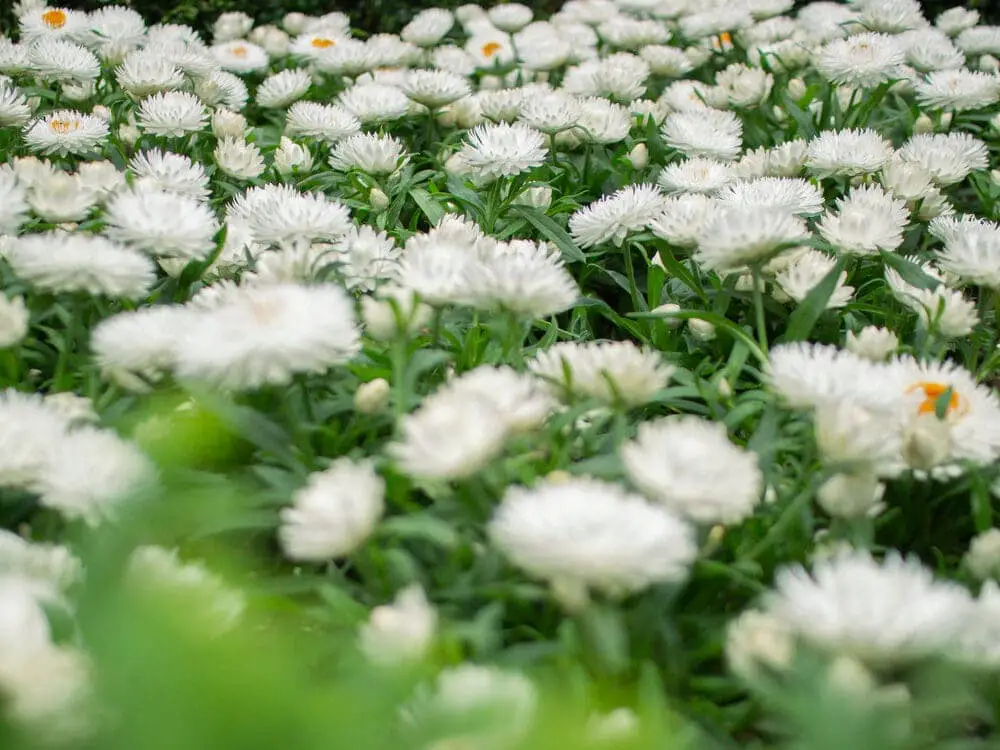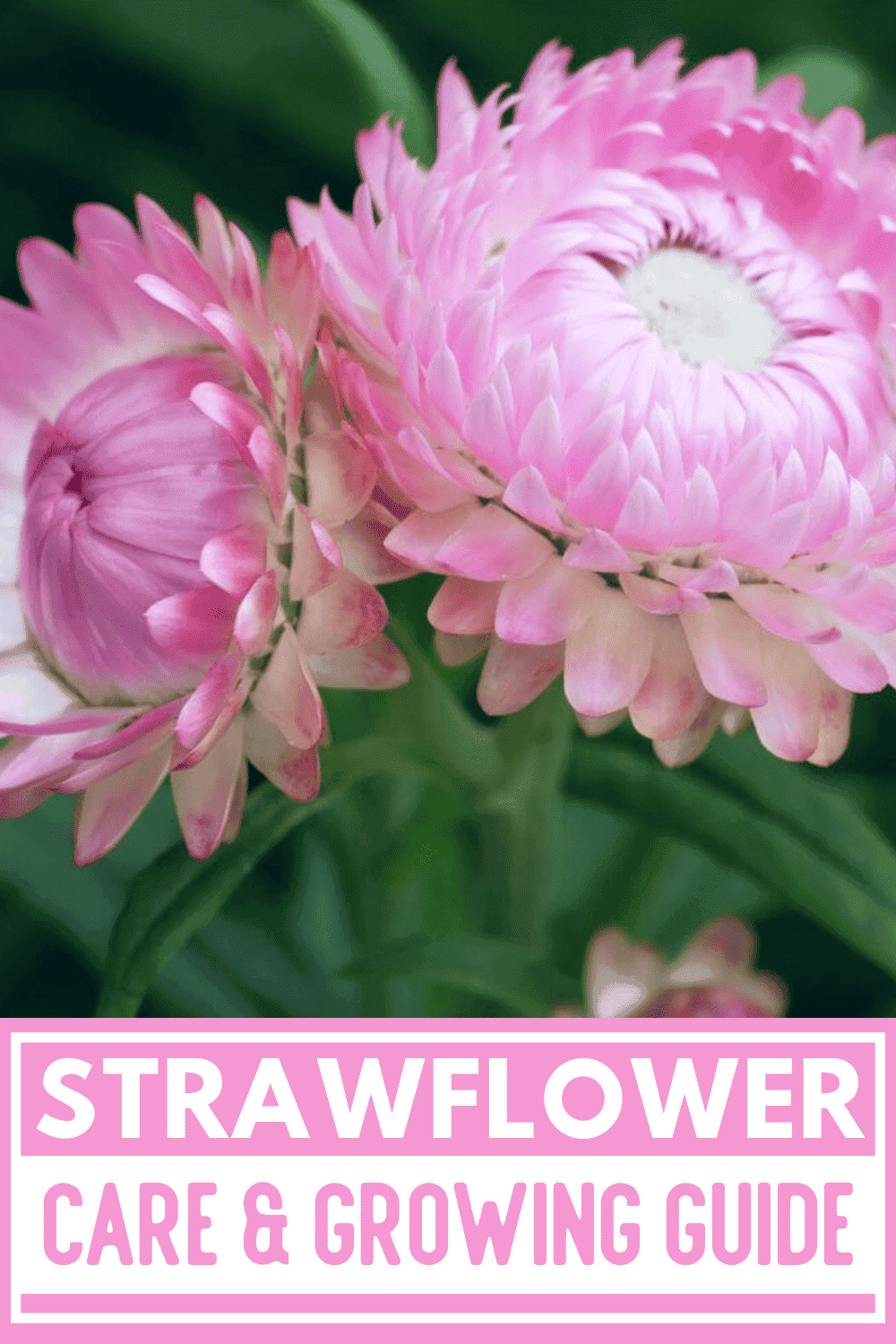The Strawflower plant is an extremely low maintenance option for those who want to add color and vibrancy to their garden.
While it looks like a daisy, this plant unique in a number of interesting ways. You will be glad for all of your work and care once it finally blooms.
Strawflower Care & Growing Guide
1. Light Requirement
The strawflower does best when it is kept in direct sunlight, but it can survive in partial shade. The amount of sunlight this plant gets plays a crucial role when it comes to how healthy it is as a whole. Partial shade won’t encourage this plant to bloom, so you need to keep that in mind.
2. Water
You should only have to water your strawflowers once a week. These plants are incredibly drought tolerant, which means that it is easy to over water them. Giving your strawflower too much water on a regular basis could lead to root rot.
It is a good idea to give your plant one inch of water for the growing season, assuming that the rain isn’t keeping the soil nice and moist. The last thing you want to do is to saturate the roots of this plant.
3. Climate
Strawflower plants can be grown as a perennial in USDA hardiness zones 8 through 10, or as an annual in zones 2 through 7. These plants definitely refer a warm climate with lots of sun.
4. Soil
You should only attempt to grow a strawflower plant in a rocky or sandy soil. The fact is that it is a lot more difficult for these plants to do well in heavier soils. You’ll want to strongly consider using some mulch to help keep the soil moist.
You’ll want to dig down into the soil anywhere from 10 to 12 inches. Put a few inches of compost on top of the soil to encourage nourishment of the plant.

5. Temperature
These plants tend to do best within a temperature range of 65 to 70 degrees Fahrenheit. They are pretty sensitive when it comes to colder or hotter weather. They also don’t like a lot of humidity. When it starts getting chilly outside, you’ll need to take these plants inside.
6. Repotting
If you are going to repot your strawflower plant, you’ll want to do so in the spring. This will give the roots a chance to settle, which is very important. You shouldn’t have to worry about needing to do this very often.
Make sure that you are very careful not to damage the root system. You’ll probably need to go up one size with the new container.
7. Speed of Growth
These plants do not grow particularly fast. They definitely thrive in full direct sunlight.
8. Height and Spread
Starflower plants can easily grow up to three feet tall with a maximum spread of 18 inches. You’ll need to keep in mind the considerable potential width of this plant when growing it initially. You don’t want to have this plant interfering with any others near your home.
9. Flowers
The flowers this plant produces can be a number of colors, including pink, white, orange, red and yellow. This is an annual flowering plant, so it can help your garden look great throughout the entire year.
10. Trimming
One of the great things about strawflower plants is that they do not require regular trimming. You will want to make a point of cutting off dead or dying leaves though. This will help to keep the plant healthy so it doesn’t take a turn for the worse.
Make certain that you thoroughly clean your scissors or pruning shears before using them on this plant. This way you won’t have to worry about passing on any infections.
Always trim this plant at a 45-degree angle horizontally across the stem close to the bottom.

Can Strawflower Plants Grow in Water?
While you may not be able to grow these plants in water, you can cut them off at the stems and put them inside of a vase. These plants are very beautiful when they flower, so they can really enhance the look of your kitchen, dining room or living room.
How to get Strawflower Plants to Flower
The best way that you can get strawflower plants to bloom is by providing them with bright direct sunlight outside. If you attempt to grow one of these plants indoors, it is unlikely to produce any flowers. Also, make sure that the soil is well-drained, and that you use a good amount of compost.
Common Strawflower Diseases
Fungal infections are sometimes an issue with strawflower plants. These plants can succumb to such infections when there is too much humidity in the air. This is also sometimes the result of watering plants too much. Fungal root rot can kill your plant very quickly.
Sometimes insects can be a problem for strawflower plants as well. If you are having any issues with grasshoppers or other insects on your plants, try sprinkling diatomaceous earth on the foliage. This method is usually very effective when it comes to keeping these pests off.
Conclusion
- Strawflower plants need to be kept in bright direct sunlight to really thrive.
- While it is possible for these plants to survive in partial shade, they are unlikely to produce many flowers if any.
- You only need to water these plants about once a week; they are very drought tolerant and prone to root rot.
- These plants can be grown as a perennial in USDA hardiness zones of 8 through 10, and as an annual in zones 2 through 7.
- The best temperature range for this plant is 65 to 70 degrees Fahrenheit. It is very sensitive to colder and hotter temperatures.
- Excess humidity can cause fungal infections, which could kill your plant fast.
- Regular trimming is not necessary, but you should cut dead leaves off when you spot them.
- If you want to get this plant to flower, simply keep it outside and provide it with plenty of bright direct sunlight.

Victoria is the owner and main author of hobby plants. She loves spending her free time in her garden planting and taking care of her plants. Victoria hopes you enjoy the content here!
![Queen Of The Night Flower [Complete Plant Care Guide] Queen Of The Night Flower [Complete Plant Care Guide]](https://www.hobbyplants.com/wp-content/uploads/2022/07/queen-of-the-night-flower-300x158.jpg)
![Mother Of Thousands Plant [Complete Plant Care Guide] Mother Of Thousands Plant [Complete Plant Care Guide]](https://www.hobbyplants.com/wp-content/uploads/2022/07/mother-of-thousands-plant-300x158.jpg)
![How Often Should You Water Pothos? [Complete Care Guide] How Often Should You Water Pothos? [Complete Care Guide]](https://www.hobbyplants.com/wp-content/uploads/2022/07/how-often-to-water-pothos-300x158.jpg)
![Can Snake Plants Live Outside? [COMPLETE CARE GUIDE] Can Snake Plants Live Outside? [COMPLETE CARE GUIDE]](https://www.hobbyplants.com/wp-content/uploads/2022/08/can-snake-plants-live-outside-300x158.jpg)
![Majesty Palm Plant Care: [Complete Beginner's Guide] Majesty Palm Plant Care: [Complete Beginner's Guide]](https://www.hobbyplants.com/wp-content/uploads/2022/08/majesty-palm-care-300x158.jpg)
![Exotic Angel Plant Care: [Complete Beginner's Guide] Exotic Angel Plant Care: [Complete Beginner's Guide]](https://www.hobbyplants.com/wp-content/uploads/2022/08/exotic-angel-plant-care-300x158.jpg)
![Do Coleus Like Sun Or Shade: [Complete Care Guide] Do Coleus Like Sun Or Shade: [Complete Care Guide]](https://www.hobbyplants.com/wp-content/uploads/2022/08/coleus-sun-or-shade-300x158.jpg)
![Snow White Waffle Plant: [Complete Care Guide] Snow White Waffle Plant: [Complete Care Guide]](https://www.hobbyplants.com/wp-content/uploads/2022/08/snow-white-waffle-plant-300x158.jpg)
![Waffle Plant Care: [Complete Beginner's Guide] Waffle Plant Care: [Complete Beginner's Guide]](https://www.hobbyplants.com/wp-content/uploads/2022/08/waffle-plant-300x158.jpg)
![Bird Of Paradise Plant Care: [Complete Beginner's Guide] Bird Of Paradise Plant Care: [Complete Beginner's Guide]](https://www.hobbyplants.com/wp-content/uploads/2022/08/bird-of-paradise-plant-300x158.jpg)
![Purple Passion Plant Care: [Complete Beginner's Guide] Purple Passion Plant Care: [Complete Beginner's Guide]](https://www.hobbyplants.com/wp-content/uploads/2022/08/purple-passion-plant-care-300x158.jpg)
![China Doll Plant Care: [Complete Beginner's Guide] China Doll Plant Care: [Complete Beginner's Guide]](https://www.hobbyplants.com/wp-content/uploads/2022/09/china-doll-plant-care-300x158.jpg)